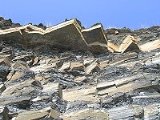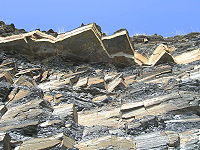
Kimmerosaurus
Encyclopedia
Kimmerosaurus is an extinct genus
of plesiosaur
from the family
Cryptoclididae
, closely related to Tatenectes
.
s, Kimmeridge Clay
deposits of Dorset
, England
(these deposits are also the root word for the Kimmeridgian stage of the Jurassic period). The second part comes from the Greek
word σαυρος (sauros), "lizard
".
(and a few cervical vertebrae), much of the plesiosaur's description comes from its teeth
, which are recurved and buccolingually compressed (compressed cheek-side to tongue-side). The premaxilla
has only eight teeth, while there are thirty-six teeth on each ramus
. The parietals
of Kimmerosaurus do not form a sagittal crest
. The overall skull of Kimmerosaurus is similar to Cryptoclidus
but much more broad.
, although the atlas
and the axis
are similar to those of the plesiosaur Colymbosaurus
. It is this lack of any post-cranial fossils, and the bone similarities that has led to the belief that Kimmerosaurus fossils could be the missing head of Colymbosaurus, a similar plesiosaur with no known skull fossils.
 Kimmerosaurus fossils are found in the Kimmeridge Clay
Kimmerosaurus fossils are found in the Kimmeridge Clay
Formation near the town of Kimmeridge
, in Dorset
, England
. This animal may have ranged through much of what is now the Jurassic Coast
, a world heritage site
in the southern United Kingdom
.
Genus
In biology, a genus is a low-level taxonomic rank used in the biological classification of living and fossil organisms, which is an example of definition by genus and differentia...
of plesiosaur
Plesiosaur
Plesiosauroidea is an extinct clade of carnivorous plesiosaur marine reptiles. Plesiosauroids, are known from the Jurassic and Cretaceous Periods...
from the family
Family (biology)
In biological classification, family is* a taxonomic rank. Other well-known ranks are life, domain, kingdom, phylum, class, order, genus, and species, with family fitting between order and genus. As for the other well-known ranks, there is the option of an immediately lower rank, indicated by the...
Cryptoclididae
Cryptoclididae
Cryptoclididae is a family of medium-sized plesiosaurs that lived from the Middle Jurassic to the Late Cretaceous. In 2010, Kaiwhekea was transferred to Leptocleididae and Aristonectes was transferred to Elasmosauridae.-Appearance:...
, closely related to Tatenectes
Tatenectes
Tatenectes is an extinct genus of cryptoclidid plesiosaur known from the Upper Member of the Sundance Formation of Wyoming. It was named by O'Keefe and Wahl in 2003 and the type species is Tatenectes laramiensis....
.
Etymology
The first part of the genus name of Kimmerosaurus comes from the location of the first Kimmerosaurus fossilFossil
Fossils are the preserved remains or traces of animals , plants, and other organisms from the remote past...
s, Kimmeridge Clay
Kimmeridge Clay
The Kimmeridge Clay Formation is a sedimentary deposit of fossiliferous marine clay which is of Jurassic age. It occurs in Europe.Kimmeridge Clay is arguably the most economically important unit of rocks in the whole of Europe, being the major source rock for oil fields in the North Sea hydrocarbon...
deposits of Dorset
Dorset
Dorset , is a county in South West England on the English Channel coast. The county town is Dorchester which is situated in the south. The Hampshire towns of Bournemouth and Christchurch joined the county with the reorganisation of local government in 1974...
, England
England
England is a country that is part of the United Kingdom. It shares land borders with Scotland to the north and Wales to the west; the Irish Sea is to the north west, the Celtic Sea to the south west, with the North Sea to the east and the English Channel to the south separating it from continental...
(these deposits are also the root word for the Kimmeridgian stage of the Jurassic period). The second part comes from the Greek
Greek language
Greek is an independent branch of the Indo-European family of languages. Native to the southern Balkans, it has the longest documented history of any Indo-European language, spanning 34 centuries of written records. Its writing system has been the Greek alphabet for the majority of its history;...
word σαυρος (sauros), "lizard
Lizard
Lizards are a widespread group of squamate reptiles, with nearly 3800 species, ranging across all continents except Antarctica as well as most oceanic island chains...
".
Description
As Kimmerosaurus is known from only a skullSkull
The skull is a bony structure in the head of many animals that supports the structures of the face and forms a cavity for the brain.The skull is composed of two parts: the cranium and the mandible. A skull without a mandible is only a cranium. Animals that have skulls are called craniates...
(and a few cervical vertebrae), much of the plesiosaur's description comes from its teeth
Tooth
Teeth are small, calcified, whitish structures found in the jaws of many vertebrates that are used to break down food. Some animals, particularly carnivores, also use teeth for hunting or for defensive purposes. The roots of teeth are embedded in the Mandible bone or the Maxillary bone and are...
, which are recurved and buccolingually compressed (compressed cheek-side to tongue-side). The premaxilla
Premaxilla
The incisive bone is the portion of the maxilla adjacent to the incisors. It is a pair of small cranial bones at the very tip of the jaws of many animals, usually bearing teeth, but not always. They are connected to the maxilla and the nasals....
has only eight teeth, while there are thirty-six teeth on each ramus
Ramus
Ramus can refer to:* A branch* A portion of a bone , as in the Ramus of the mandible or Superior pubic ramus* A nerve ramus such as the Dorsal ramus of spinal nerve* Petrus Ramus...
. The parietals
Parietal bone
The parietal bones are bones in the human skull which, when joined together, form the sides and roof of the cranium. Each bone is roughly quadrilateral in form, and has two surfaces, four borders, and four angles. It is named from the Latin pariet-, wall....
of Kimmerosaurus do not form a sagittal crest
Sagittal crest
A sagittal crest is a ridge of bone running lengthwise along the midline of the top of the skull of many mammalian and reptilian skulls, among others....
. The overall skull of Kimmerosaurus is similar to Cryptoclidus
Cryptoclidus
Cryptoclidus was a genus of plesiosaur from the Middle Jurassic period of England.-Discovery:Cryptoclidus is a plesiosaur whose specimens include adult and juvenile skeletons, and remains which have been found in various degrees of preservation in England, Northern France, Russia, and South America...
but much more broad.
Fossils
There are very few fossil remains of Kimmerosaurus known. In fact, nothing has been found to show what Kimmerosaurus may have looked like below the neckCervical vertebrae
In vertebrates, cervical vertebrae are those vertebrae immediately inferior to the skull.Thoracic vertebrae in all mammalian species are defined as those vertebrae that also carry a pair of ribs, and lie caudal to the cervical vertebrae. Further caudally follow the lumbar vertebrae, which also...
, although the atlas
Atlas (anatomy)
In anatomy, the atlas is the most superior cervical vertebra of the spine.It is named for the Atlas of Greek mythology, because it supports the globe of the head....
and the axis
Axis (anatomy)
In anatomy, the second cervical vertebra of the spine is named the axis or epistropheus.It forms the pivot upon which the first cervical vertebra , which carries the head, rotates....
are similar to those of the plesiosaur Colymbosaurus
Colymbosaurus
Colymbosaurus is a genus of English plesiosaur described in 1874 by Seeley. The only bones found include 74 vertebrae, ribs, coracoids, a scapula and fore and hind limbs . This specimen may be the missing body of Kimmerosaurus, which would make this a cryptoclid instead of an elasmosaurid...
. It is this lack of any post-cranial fossils, and the bone similarities that has led to the belief that Kimmerosaurus fossils could be the missing head of Colymbosaurus, a similar plesiosaur with no known skull fossils.
Distribution

Kimmeridge Clay
The Kimmeridge Clay Formation is a sedimentary deposit of fossiliferous marine clay which is of Jurassic age. It occurs in Europe.Kimmeridge Clay is arguably the most economically important unit of rocks in the whole of Europe, being the major source rock for oil fields in the North Sea hydrocarbon...
Formation near the town of Kimmeridge
Kimmeridge
Kimmeridge is a small village in the Purbeck district of Dorset, England, situated on the English Channel coast. Kimmeridge is about south of Wareham and about west of Swanage and is on the Isle of Purbeck...
, in Dorset
Dorset
Dorset , is a county in South West England on the English Channel coast. The county town is Dorchester which is situated in the south. The Hampshire towns of Bournemouth and Christchurch joined the county with the reorganisation of local government in 1974...
, England
England
England is a country that is part of the United Kingdom. It shares land borders with Scotland to the north and Wales to the west; the Irish Sea is to the north west, the Celtic Sea to the south west, with the North Sea to the east and the English Channel to the south separating it from continental...
. This animal may have ranged through much of what is now the Jurassic Coast
Jurassic Coast
The Jurassic Coast is a World Heritage Site on the English Channel coast of southern England. The site stretches from Orcombe Point near Exmouth in East Devon to Old Harry Rocks near Swanage in East Dorset, a distance of ....
, a world heritage site
World Heritage Site
A UNESCO World Heritage Site is a place that is listed by the UNESCO as of special cultural or physical significance...
in the southern United Kingdom
United Kingdom
The United Kingdom of Great Britain and Northern IrelandIn the United Kingdom and Dependencies, other languages have been officially recognised as legitimate autochthonous languages under the European Charter for Regional or Minority Languages...
.
External links
- Entry on Kimmerosaurus at The Plesiosaur Site
- Palaeos Vertebrates entry

